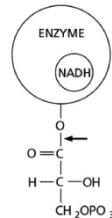The simultaneous oxidation and phosphorylation of glyceraldehyde 3-phosphate forms a highly reactive covalent thioester bond between a cysteine side chain (reactive group ?SH) on the enzyme (glyceraldehyde 3-phosphate dehydrogenase) and the oxidized intermediate (see the arrow in Figure 13-23A) .If the enzyme had a serine (reactive group ?OH) instead of a cysteine at this position, which could form only a much lower energy bond to the oxidized substrate (see the arrow in Figure 13-23B) , how might this new enzyme act? (A) 
(B) 
Figure 13-23
A) It would oxidize the substrate and phosphorylate it without releasing it.
B) It would oxidize the substrate but not release it.
C) It would phosphorylate the substrate on the 2 position instead of the 1 position.
D) It would behave just like the normal enzyme.
Correct Answer:
Verified
Q20: Which of the following cells rely exclusively
Q21: In the final stage of the oxidation
Q22: In step 1 of the citric acid
Q23: The citric acid cycle is a series
Q24: The first energy-generating steps in glycolysis begin
Q26: Step 6 of the citric acid cycle
Q27: In step 4 of the citric acid
Q28: The oxygen-dependent reactions required for cellular respiration
Q29: In step 3 of the citric acid
Q30: In the final step of the citric
Unlock this Answer For Free Now!
View this answer and more for free by performing one of the following actions

Scan the QR code to install the App and get 2 free unlocks

Unlock quizzes for free by uploading documents